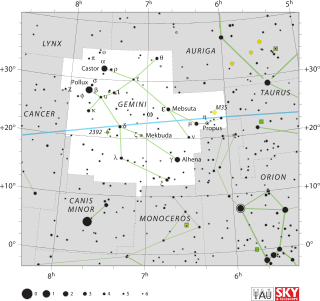Xi Geminorum

| |
| Observation data Epoch J2000.0 Equinox J2000.0 (ICRS) | |
|---|---|
| Constellation | Gemini |
| Right ascension | 06h 45m 17.36432s[1] |
| Declination | +12° 53′ 44.1311″[1] |
| Apparent magnitude (V) | 3.35[2] |
| Characteristics | |
| Spectral type | F5 IV-V[3] |
| U−B color index | +0.06[4] |
| B−V color index | +0.43[4] |
| Astrometry | |
| Radial velocity (Rv) | +25.6[2] km/s |
| Proper motion (μ) | RA: –115.73[1] mas/yr Dec.: –190.55[1] mas/yr |
| Parallax (π) | 55.56 ± 0.19[1] mas |
| Distance | 58.7 ± 0.2 ly (18.00 ± 0.06 pc) |
| Absolute magnitude (MV) | 2.14[5] |
| Details | |
| Mass | 1.706 ± 0.012[6] M☉ |
| Radius | 2.710 ± 0.021[6] R☉ |
| Luminosity | 11.574 ± 0.238[6] L☉ |
| Surface gravity (log g) | 3.81 ± 0.02[7] cgs |
| Temperature | 6,480 ± 39[6] K |
| Metallicity [Fe/H] | 0.00 ± 0.01[7] dex |
| Rotational velocity (v sin i) | 66.1 ± 3.3[8] km/s |
| Age | 1.5[9] Gyr |
| Other designations | |
| Database references | |
| SIMBAD | data |
Xi Geminorum (ξ Gem) is a star in the zodiac constellation Gemini with the traditional name Alzirr.[10] It forms one of the four feet of the outline demarcating the Gemini twins.[11] The star has an apparent visual magnitude of 3.35,[2] which is bright enough for it to be seen with the naked eye. From parallax measurements, its distance from the Earth can be estimated as 58.7 light-years (18.0 parsecs).[1]
Alzirr has a stellar classification of F5 IV-V, which is subgiant star that is in the process of evolving away from the main sequence of stars like the Sun. It has about 162%[5] of the Sun's mass and is radiating more than 11 times the luminosity of the Sun.[7] This energy is being emitted from the outer envelope of the star at an effective temperature of 6,464 K.[7] This causes the star to take on the yellow-white hue common to F-type stars.[12]
X-ray emission has been detected from this star, which has an estimated X-ray luminosity of 1.06 × 1029 erg s−1.[5] It has the spectroscopic signature of a rapidly rotating star, with a projected rotational velocity of about 66 km s−1.[8] Although generally considered a single star, there is some evidence that it may instead be a spectroscopic binary system consisting of two component stars of equal mass.[13]
Name
The proper name of Xi Geminorum is Alzirr, meaning "the button" in Arabic. This star, along with γ Gem (Alhena), μ Gem (Tejat Posterior), ν Gem and η Gem (Tejat Prior) were Al Han'ah, "the brand" (on the neck of the camel). They also were associated in Al Nuḥātai, the dual form of Al Nuḥāt, "a Camel's Hump".[10]
In Chinese, 井宿 (Jǐng Su), meaning Well (asterism), refers to an asterism consisting of ξ Geminorum, μ Geminorum, ν Geminorum, γ Geminorum, ε Geminorum, 36 Geminorum, ζ Geminorum and λ Geminorum.[14] Consequently, ξ Geminorum itself is known as 井宿四 (Jǐng Su sì, English: the Fourth Star of Well.)[15]
References
- 1 2 3 4 5 6 van Leeuwen, F. (November 2007), "Validation of the new Hipparcos reduction", Astronomy and Astrophysics, 474 (2): 653–664, arXiv:0708.1752
 , Bibcode:2007A&A...474..653V, doi:10.1051/0004-6361:20078357
, Bibcode:2007A&A...474..653V, doi:10.1051/0004-6361:20078357 - 1 2 3 Wielen, R.; et al. (1999), "Sixth Catalogue of Fundamental Stars (FK6). Part I. Basic fundamental stars with direct solutions", Veröff. Astron. Rechen-Inst. Heidelb, Astronomisches Rechen-Institut Heidelberg, 35 (35), Bibcode:1999VeARI..35....1W
- ↑ Gray, R. O.; Corbally, C. J.; Garrison, R. F.; McFadden, M. T.; Robinson, P. E. (2003). "Contributions to the Nearby Stars (NStars) Project: Spectroscopy of Stars Earlier than M0 within 40 Parsecs: The Northern Sample. I". The Astronomical Journal. 126 (4): 2048. arXiv:astro-ph/0308182
 . Bibcode:2003AJ....126.2048G. doi:10.1086/378365.
. Bibcode:2003AJ....126.2048G. doi:10.1086/378365. - 1 2 Johnson, H. L.; et al. (1966). "UBVRIJKL photometry of the bright stars". Communications of the Lunar and Planetary Laboratory. 4 (99): 99. Bibcode:1966CoLPL...4...99J.
- 1 2 3 Pizzolato, N.; Maggio, A.; Sciortino, S. (September 2000), "Evolution of X-ray activity of 1-3 Msun late-type stars in early post-main-sequence phases", Astronomy and Astrophysics, 361: 614–628, Bibcode:2000A&A...361..614P
- 1 2 3 4 Boyajian, Tabetha S.; et al. (February 2012), "Stellar Diameters and Temperatures. I. Main-sequence A, F, and G Stars", The Astrophysical Journal, 746 (1): 101, arXiv:1112.3316
 , Bibcode:2012ApJ...746..101B, doi:10.1088/0004-637X/746/1/101. See Table 10 & 12.
, Bibcode:2012ApJ...746..101B, doi:10.1088/0004-637X/746/1/101. See Table 10 & 12. - 1 2 3 4 Pijpers, F. P. (March 2003), "Selection criteria for targets of asteroseismic campaigns", Astronomy and Astrophysics, 400: 241–248, arXiv:astro-ph/0303032
 , Bibcode:2003A&A...400..241P, doi:10.1051/0004-6361:20021839
, Bibcode:2003A&A...400..241P, doi:10.1051/0004-6361:20021839 - 1 2 Reiners, A. (January 2006), "Rotation- and temperature-dependence of stellar latitudinal differential rotation", Astronomy and Astrophysics, 446 (1): 267–277, arXiv:astro-ph/0509399
 , Bibcode:2006A&A...446..267R, doi:10.1051/0004-6361:20053911
, Bibcode:2006A&A...446..267R, doi:10.1051/0004-6361:20053911 - ↑ Holmberg, J.; Nordstrom, B.; Andersen, J. (July 2009). "The Geneva-Copenhagen survey of the solar neighbourhood. III. Improved distances, ages, and kinematics". Astronomy and Astrophysics. 501 (3): 941–947. arXiv:0811.3982
 . Bibcode:2009A&A...501..941H. doi:10.1051/0004-6361/200811191.
. Bibcode:2009A&A...501..941H. doi:10.1051/0004-6361/200811191. - 1 2 Allen, R. H. (1963). Star Names: Their Lore and Meaning (Reprint ed.). New York, NY: Dover Publications Inc. p. 234. ISBN 0-486-21079-0. Retrieved 2010-12-12.
- ↑ O'Meara, Stephen James (2002), The Caldwell objects, Deep-sky companions, Cambridge University Press, p. 185, ISBN 0-521-82796-5
- ↑ "The Colour of Stars", Australia Telescope, Outreach and Education, Commonwealth Scientific and Industrial Research Organisation, December 21, 2004, retrieved 2012-01-16
- ↑ Fuhrmann, K.; et al. (March 2011), "BESO échelle spectroscopy of solar-type stars at Cerro Armazones", Monthly Notices of the Royal Astronomical Society, 411 (4): 2311–2318, Bibcode:2011MNRAS.411.2311F, doi:10.1111/j.1365-2966.2010.17850.x
- ↑ (Chinese) 中國星座神話, written by 陳久金. Published by 台灣書房出版有限公司, 2005, ISBN 978-986-7332-25-7.
- ↑ (Chinese) 香港太空館 - 研究資源 - 亮星中英對照表 Archived October 25, 2008, at the Wayback Machine., Hong Kong Space Museum. Accessed on line November 23, 2010.
External links
- Kaler, James B., "Al ZIRR (Xi Geminorum)", SIMBAD, University of Illinois, retrieved 2012-01-20